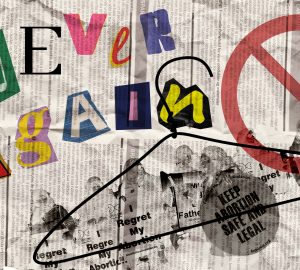
Graphic by Rachel Carp
South Carolina has recently become one of many states to pass a bill banning abortions. Currently, 18 states limit access to abortions, most of which cut off access to abortion by the 20th week of pregnancy. The debate around abortion seems to come and go, reappearing in the spotlight during elections.
At the center of this is Roe v. Wade, the United States Supreme Court’s version of a Super Bowl wardrobe malfunction. Everyone has an opinion on it and women get the short end of the stick no matter what. Roe v. Wade started when a pregnant, single woman brought a class action lawsuit to the Supreme Court over the constitutionality of Texas’s then criminal abortion laws. At the time, women could only get an abortion if not doing so threatened the mother’s life. The case eventually ruled in Roe’s favor in 1973 on the basis of the 9th amendment, 14th amendment, and two other Supreme Court cases I’m sure you’re excited to read about.
The 9th amendment is easy — all it says is, “The enumeration in the Constitution, of certain rights, shall not be construed to deny or disparage others retained by the people.” This is, pardon my French, the founding fathers’ way of covering their *sses. Any right they forgot to include in the Constitution can still apply to the people. In other words — when in doubt, favor the people.
The 14th amendment is also easy because you can stop reading after the first section and still get everything relevant to Roe v. Wade. It says, “All persons born or naturalized in the United States, and subject to the jurisdiction thereof, are citizens of the United States and of the State wherein they reside. No State shall make or enforce any law which shall abridge the privileges or immunities of citizens of the United States; nor shall any State deprive any person of life, liberty, or property, without due process of law; nor deny to any person within its jurisdiction the equal protection of the laws.”
The 14th amendment was passed after the Civil War, and its main goal was to define citizenship to include African Americans. That’s where the word “persons” in the first sentence comes from, “All persons born or naturalized.” In the context of Roe v. Wade, this means women count as citizens who have rights protected by the Constitution. Except, at the time, for voting, of course.
The two court cases preceding Roe v. Wade were Griswold v. Connecticut, which argued married couples had a right to privacy, and Eisenstadt v. Baird, which argued single people also have a right to privacy. (This apparently doesn’t apply on Valentine’s Day.)
So, the thread legal abortion is dangling on is as thin a single woman’s right to privacy. The State cannot interfere with her personal decisions, and abortion is a personal decision.
There are loopholes here, which is where the decades-long fight to restrict abortion access comes from. States can require parental notification. States can outlaw abortions after the first trimester (1-12 weeks). States can defund clinics that provide abortions. States can require waiting periods between initial abortion consultation and the procedure.
In Georgia, for example, abortion is banned around 20 weeks with limited exceptions. State Medicaid and insurance under the ACA do not cover abortion. Parents must receive notification prior to the abortion, though minors may file a petition to excuse them from this requirement. And patients must wait 24 hours between abortion counseling and the procedure. Technically, yes, abortion is legal, but it is not accessible.
Roe v. Wade did not make all types of abortion legal or accessible in this country, it affirmed an individual’s right to medical privacy.
It is unlikely Roe v. Wade will be completely overturned, but the Supreme Court will likely support the chipping away of abortion access. Financially, abortions are already out of reach. The federal government and many insurance companies do not support abortion. Legally, abortion is allowed, but in reality, we may return to a pre Roe v. Wade country where abortion is restricted to cases of rape, incest and fetal abnormalities only. A select few states will allow access to abortion, such as California, but there will be no federal standard to make it a realistic option. We can’t expect a woman in South Carolina to travel across the entire country to get an abortion in California.
I can understand the moral panic around abortion. People are protective of infants and see the gift of life as holy. But banning abortion generates more harm than good. Mothers will still seek out ways to terminate their pregnancies regardless of the law. Children raised by parents who aren’t prepared will suffer. The effort, time and money going into the abortion debate could be spent elsewhere to raise and sustain the standard of living.
As of this writing, South Carolina’s “Heartbeat Bill” is not in effect. One day after its signing, a federal court blocked it. U.S. District Court Judge Mary Geiger Lewis granted a two-week restraining order, and Planned Parenthood has filed an emergency lawsuit to challenge the bill. That said, South Carolina already bans abortions after 20 weeks with limited exceptions. Funding and insurance coverage are restricted by the state. Any minor seeking an abortion must provide parental permission instead of notification. And patients must wait 24 hours between counseling and the procedure.
For information on access to abortion and contraceptive measures, visit Planned Parenthood.


























